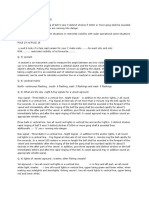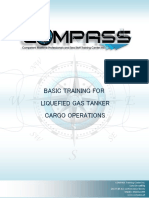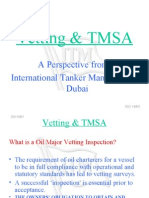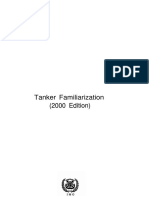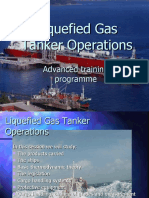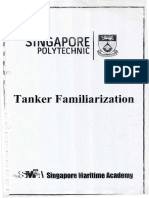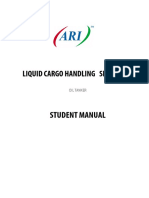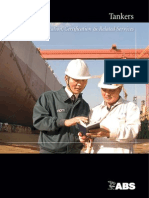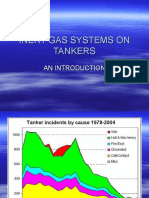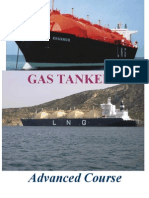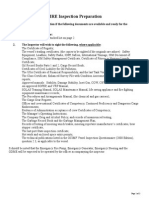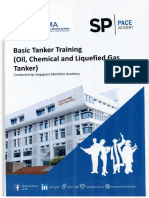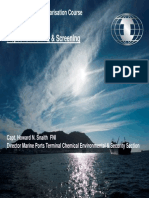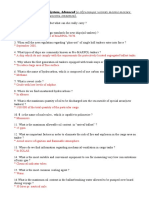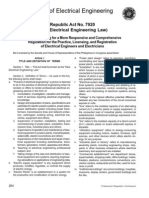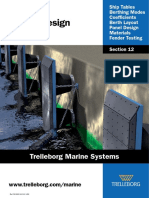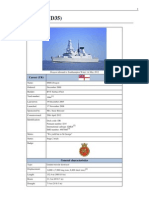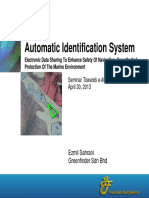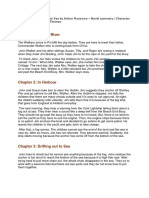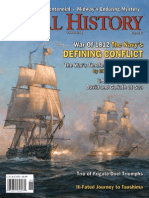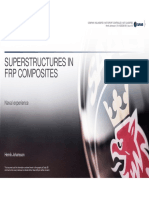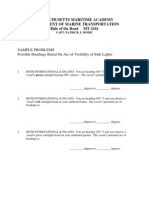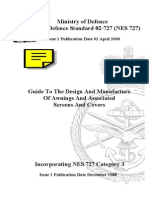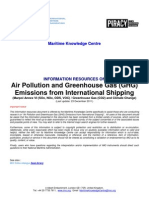100%(8)100% found this document useful (8 votes)
2K viewsBasic Training For Oil and Chemical Tankers Cargo
Basic Training For Oil and Chemical Tankers Cargo
Uploaded by
Camilla AlbaThis document outlines the course contents for a basic training course on oil and chemical tankers. It covers topics like the design of oil tankers, types of cargoes carried, safety procedures, and pollution prevention. The course is intended to meet the mandatory minimum training requirements for crew with cargo-related duties on tankers. It provides a basic understanding of hydrocarbon properties, tanker systems, cargo operations, health hazards, and emergency response. The goal is to teach personnel how to safely handle cargoes and prevent pollution to protect people and the environment.
Copyright:
© All Rights Reserved
Available Formats
Download as PPT, PDF, TXT or read online from Scribd
Basic Training For Oil and Chemical Tankers Cargo
Basic Training For Oil and Chemical Tankers Cargo
Uploaded by
Camilla Alba100%(8)100% found this document useful (8 votes)
2K views140 pagesThis document outlines the course contents for a basic training course on oil and chemical tankers. It covers topics like the design of oil tankers, types of cargoes carried, safety procedures, and pollution prevention. The course is intended to meet the mandatory minimum training requirements for crew with cargo-related duties on tankers. It provides a basic understanding of hydrocarbon properties, tanker systems, cargo operations, health hazards, and emergency response. The goal is to teach personnel how to safely handle cargoes and prevent pollution to protect people and the environment.
Original Title
Basic Training for Oil and Chemical Tankers Cargo
Copyright
© © All Rights Reserved
Available Formats
PPT, PDF, TXT or read online from Scribd
Share this document
Read this document in other languages
Did you find this document useful?
Is this content inappropriate?
This document outlines the course contents for a basic training course on oil and chemical tankers. It covers topics like the design of oil tankers, types of cargoes carried, safety procedures, and pollution prevention. The course is intended to meet the mandatory minimum training requirements for crew with cargo-related duties on tankers. It provides a basic understanding of hydrocarbon properties, tanker systems, cargo operations, health hazards, and emergency response. The goal is to teach personnel how to safely handle cargoes and prevent pollution to protect people and the environment.
Copyright:
© All Rights Reserved
Available Formats
Download as PPT, PDF, TXT or read online from Scribd
Download as ppt, pdf, or txt
100%(8)100% found this document useful (8 votes)
2K views140 pagesBasic Training For Oil and Chemical Tankers Cargo
Basic Training For Oil and Chemical Tankers Cargo
Uploaded by
Camilla AlbaThis document outlines the course contents for a basic training course on oil and chemical tankers. It covers topics like the design of oil tankers, types of cargoes carried, safety procedures, and pollution prevention. The course is intended to meet the mandatory minimum training requirements for crew with cargo-related duties on tankers. It provides a basic understanding of hydrocarbon properties, tanker systems, cargo operations, health hazards, and emergency response. The goal is to teach personnel how to safely handle cargoes and prevent pollution to protect people and the environment.
Copyright:
© All Rights Reserved
Available Formats
Download as PPT, PDF, TXT or read online from Scribd
Download as ppt, pdf, or txt
You are on page 1of 140
At a glance
Powered by AI
The document discusses the design, types, and cargoes of oil tankers as well as basic science concepts, cargo handling systems, tanker operations, health and safety procedures, and pollution prevention.
The main types of oil tankers discussed are crude tankers, which transport unrefined crude oil, and product tankers, which generally transport refined petroleum products and are smaller than crude tankers.
Some of the key basic science concepts discussed include the states of matter (solids, liquids, gases), sources of hydrocarbons, chemical reactions, controlled tank atmospheres, and principles of electrostatics.
Basic Training for Oil and
Chemical Tankers Cargo
Operation Course Handout
SN
Course Contents
Page No.
1 Introduction
1
2 The Oil Tanker
2
2.1 Design and Development of oil tanker
2
2.2 Types of Tankers in current service
4
2.3 Types of cargo shipped in oil tankers
5
3 Basic Science Concepts
7
3.1 General introduction
7
3.2 Solids, Liquids, Gases and changes of states
7
3.3 Sources of Hydrocarbon
8
3.4
Chemical Reactions
8
3.5
Controlled tank atmosphere
10
3.6 Principles of Electrostatics
17
4 Oil Tanker Handling System
20
4.1
General pipe line system
20
4.2
Basic pumping Concept and equipments
22
4.3
Cargo and Ballast measuring Device
25
4.4
Venting arrangement
27
4.5
Cargo heating system
29
5 Tanker Operation
30
5.1 Cargo loading and Discharging Operation
33
5.2 Tank washing procedures
32
5.3 Purging and Gas Freeing
36
6 Health, Safety and Emergency Procedures
39
6.1 Health hazards associated with petroleum cargo
39
6.2 Detection
40
6.3 First Aid treatment
40
6.4 Personal Protection and safety Equipments
42
6.5 Fire fighting principles and contro
45
6.6 General Safety Precautions
49
7 Pollution Prevention
50
7.1 Pollution of marine environment
50
7.2 Response to marine spills
52
ANNEX TERMINOLOGY
1. Introduction
This course syllabus is prepared to meet mandatory minimum
competence in basic training for sea going personnel with specific
tasks, duties and responsibilities related to cargo and cargo
equipment on oil and chemical tankers as per STCW Code A-V/1-1.
This tanker familiarization course comprises three main parts. These
are the basic understanding of the characteristics of oils; personnel
safety and pollution prevention; and general shipboard cargo-
handling system.
The first part covers the proprieties and associated hazards related
to the cargoes.
The second part covers the means and measures to control the
hazards and to prevent pollution, for the protection of personnel and
the environment.
The third part provides a general overview of cargo-handling
equipment and operations on board tankers.
This basic training is for oil and chemical tanker
is approved by Flag Administration for officers
and ratings assigned on specific duties and
responsibilities related to cargo or cargo
equipment on oil and chemical tankers;
This course covers the requirements for level 1
training required by STCW Convention, as
amended, including 2010 Manila amendments,
Regulation V/1-1 Paragraph 2.
2. THE OIL TANKER
2.1Design and Development of Oil Tanker
An oil tanker, also known as a petroleum tanker, is
a merchant ship designed for the bulk transport of oil.
There are two basic types of oil tankers: the crude
tanker and the product tanker.
Crude tankers move large quantities of unrefined crude
oil from its point of extraction to refineries.
Product tankers, generally much smaller, are designed
to move petrochemicals from refineries to points near
consuming markets.
Oil tankers are often classified by their size as well as
their occupation. The size classes range from inland or
coastal tankers of a few thousand metric tons
of deadweight (DWT) to the mammoth ultra large crude
carriers (ULCCs) of 550,000 DWT.
Tankers move approximately 2,000,000,000 metric tons
(2200,000,000 short tons) of oil every year. Second only to pipelines
in terms of efficiency, the average cost of oil transport by tanker
amounts to only two or three United States cents per 1 US gallon.
Tankers have grown significantly in size since World War II. While a
typical T2 tanker of the World War II era was 162 m long and had a
capacity of 16,500 DWT, the ultra-large crude carriers (ULCC) built
in the 1970s were over 400 m long and had a capacity of
500,000 DWT. Several factors encouraged this growth. Hostilities in
the Middle East which interrupted traffic through the Suez Canal
contributed, as did nationalization of Middle East oil
refineries. Fierce competition among ship owners also played a
part. But apart from these considerations is a simple economic
advantage: the larger an oil tanker is, the more cheaply it can move
crude oil, and the better it can help meet growing demands for oil.
With the exception of the pipeline, the tanker is the most cost-
effective way to move oil today. Worldwide, tankers carry some 2
billion barrels annually, and the cost of transportation by tanker
amounts approximately to only US$0.02 per gallon at the pump.
The cargo tank area is separated from the vessels after section by
a Cofferdam cargo pump room oil fuel bunker or permanent ballast
tanks Machinery spaces, accommodation ,cargo control room must
be in position aft of the cargo tanks slop tanks cargo pump room and
cofferdams.
Means shall be provided to keep any deck spills away from the
accommodation and service housing. This is in the form of a
permanent coaming extending the breadth of the vessel.
Exterior boundaries of deckhouses enclosing accommodation are
insulated for the portion facing the cargo tank area and for a
distance of three meters aft. Entrance air inlets and openings to
accommodation spaces shall not face the cargo area.
Windows and ports facing the cargo deck area and for three meters
aft of the front boundary are of the non- opening type.
The accommodation air conditioning must be of the recirculating
type so as to prevent gases entering the accommodation from the
outside. At this point it should be mentioned that loading ports will
stop berthing if the air conditioning plant is out of commission.
At a terminal hazardous areas are graded in to hazardous zones
depending on the probability of the presence of a flammable gas
mixture. The zones are graded accordingly
ZONE 0 An area in which a flammable gas mixture is
continuously present or is present for long periods.
ZONE 1 An area in which there is likely to be a
flammable gas mixture Under normal operating
conditions
ZONE 2 An area in which the presence of flammable
mixture is un Likely but if such a mixture is present it is
likely to persist for only a short period.
When a tanker is at berth it is possible that an area
which is regarded as safe may fall in to one of the
hazardous zones of the terminal.
2.2Types of oil tankers in current service
Oil tankers:
Crude Oil tankers:
Product tankers:
Combination carriers:
While no standardized system for the classification of oil
tankers exists; the fleet is typically divided into four major
categories based on carrying capacity. These categories
are ULCCs and VLCCs, Suezmax, Aframax, and
Panamax and Handysize tankers. To benefit from
economies of scale charterers typically charter the
largest possible vessel that can be accommodated in a
particular voyages arrival and discharge ports.
Single hull and double hull oil tankers
Single hull tankers are more likely than double hull
vessels to rupture and break up, spilling oil into the sea.
A double hull is a ship hull design and construction
method invented by Leonardo da Vinci where the bottom
and sides of the ship have two complete layers of
watertight hull surface: one outer layer forming the
normal hull of the ship, and a second inner hull which is
some distance inboard, typically by a few feet, which
forms a redundant barrier to seawater in case the outer
hull is damaged and leaks.
The space between the two hulls is often used for
storage of fuel or ballast water.
Double hulls are a more extensive safety
measure than double bottoms, which have two
hull layers only in the bottom of the ship but not
the sides.
Double hulls' ability to prevent or reduce oil spills
led to their being standardized for other types of
ships including oil tankers by the International
Convention for the Prevention of Pollution from
Ships or MARPOL Convention.
A double hull does not protect against major,
high-energy collisions or groundings which
cause the majority of oil pollution.
2.3 Types of cargo shipped in oil tankers
Oil means petroleum in any form,
including crude oil, fuel oil, sludge, oil
refuse and refined products (Other than
petrochemicals).
List of oils:
List of oils:
Asphalt solutions Gasolineblending stocks
Blending stocks Alkylates fuel
Roofers flux Reformates
Straight run residue Polymer fuel
Oils Gasolines
Clarified Casinghead
(natural)
Crude oil Automotive
Mixtures containing crude oil Aviation
Diesel oil Straight run
Fuel oil no. 4 Fuel oil no.
1(kerosene)
Fuel oil no. 5 Fuel oil no. 1-D
Fuel oil no. 6 Fuel oil no. 2
Residual fuel oil Fuel oil no. 2-D
Road oil
Transformer oil Jet fuels
Aromatic oil (excluding vegetable oil) JP-1 (kerosene)
Lubricating oils and blending stocks JP-3
Mineral oil JP-4
Motor oil JP-5 (kerosene,
heavy)
Penetrating oil Turbo fuel
Spindle oil Kerosene
Turbine oil Mineral spirit
Distillates Naphtha
Straight run Solvent
Flashed feed stocks Petroleum
Heartcut distillate oil
Gas oil
Cracked
Crude petroleum as discharged at the well head is a
mixture of a large number of different hydrocarbon
molecules.
Hydrocarbons is the common name for substances
composed of only the elements hydrogen and carbon
The composition of petroleum depends on its source
The petroleum remaining after the removal of products
such as methane is termed crude oil
3. BASIC SCIENCE CONCEPTS
3.1 GENERAL INTRODUCTION
All matter, solid, liquid or gas is made up of
particles. Physics is concerned with the mass of
these particles and how they behave when the
pressure and temperature are changed. This is
the subject of the first section in these notes.
In contrast, these particles known as atoms
and molecules can react with each other to
form new compounds. These are chemical
reactions and involve chemical bonding which
will be discussed in the second section.
3.2 SOLIDS, LIQUIDS, GASES and CHANGES OF
STATE
All matter exists in one of three forms solid, liquid or
gas. In this section the essential properties of these
states will be discussed together with the energy
changes which occur when a solid melts or liquid
evaporates (A CHANGE OF STATE).
3.2.1Solids
At about 273C, all substances are solid and the
particles are rigidly held in place by a balance between
attractive forces and repulsive forces. This temperature
is known as ABSOLUTE ZERO and the particles are
considered to have no energy.
For this reason, heat is a form of energy that can transfer
matter from one state to another. When heat is applied
on the solid state of a matter, it changes it to liquid state.
3.2.2Liquids
In a liquid, the particles are not free to move anywhere.
There are still attractive and repulsive forces between
them and the movement of the particles is restricted.
Thus a liquid:
will take shape of the vessel that contains it.
will flow under the influence of a force (liquids can be
poured and pumped).
LIQUIDS HAVE A DEFINITE VOLUME BUT NO FIXED
SHAPE
As further heat is applied, the particles gain more energy
and move faster. The temperature will increase and the
liquid will expand. If a particle on the surface has enough
energy, it will be able to overcome the attraction of the
other particles and escape in to the vapour phase. This
is known as EVAPORATION.
3.2.3Gases
In a gas, the particles are too far apart to have any
substantial attraction or repulsion between the particles.
Therefore they are free to move and to fill the whole of
the space available to them.
GASES HAVE NO FIXED SHAPE OR VOLUME
3.3 SOURCES OF HYDROCARBONS
Crude Oil
Crud Oil is a mixture of hydrocarbons formed
from the remains of marine plants and other
living organisms that lived millions of years ago.
Refining Crude Oil
Refining of crude oil is done in a refinery by the
process of distillation which produces gases,
petrol, Kerosene, Diesel oil, gas oil, lubricating
oil, Fuel oil, Paraffin waxes and Bitumen. These
are produced by the distillation of crude oil at
different level.
Eg. FRACTION APRROX%IN CRUDE OIL %DEMAND
Gases 2 4
Petrol 16 27
Kerosine 13 8
Gas oil etc 19 23
Fuel oil/bitumen 50 38
3.4Chemical Reactions
There are different types of chemical reactions,
but we will only deal with combustion.
3.4.1 COMBUSTION ( OXIDATION)
Combustion is a chemical reaction that sustains
a flame a flame is gaseous matter raised to
incandescence.
The requirements for combustion to take place
are FUEL, OXYGEN AND SOURCE OF
IGNITION (HEAT).fireOxygen Flame
Heat
For ignition to occur the proportion of fuel vapour to oxygen or to air
must be within the flammable limits.
fire
Oxygen
Flam
e
Heat
Flammable range (Explosive Limits)
The range of composition by volume % of flammable gas/vapor in
a mixture with air which will explode when ignited. If the % volume
of flammable gas is below the lower flammable (Explosive) Limit
(LFL or LEL), the composition is too lean for sustained combustion;
above the UFL (UEL) mixtures are too rich with respect to the fuel,
i.e. there is insufficient oxygen to sustain combustion. Depending
on the circumstances, a lean mixture may become enriched with
flammable gas, or an over-rich mixture become diluted with air, until
in either case the composition comes within the flammable range.
Sources of oxygen must be excluded from potentially hazardous
areas.
Spillages of flammable liquefied gases on land or water create
vapour clouds which present a fire hazard for some distance around,
and particularly downwind. Close to the spill there will be an over-
rich cloud (above the UFL) but further away there is a region within
which is a mixture in the flammable range.
Flash Point Is the lowest temperature at which a liquid
evolves enough vapour to form a flammable mixture with
air.
Auto-ignition Temperature - is the minimum T at which
a flammable vapour-air mixture can ignite
spontaneously; risk may arise if vapour escape near a
hot surface.
Flammability Suppression by Inert Gas is essential
when a tank which has flammable liquid cargo, or
previously contained a flammable liquid.
EXPLOSIONS
There are two basic reasons for the occurrence of an
explosion
(i) Thermal explosion
During the process of combustion heat energy is liberated
If the rate at which the heat is liberated is greater than the rate at
which the heat is dissipated to the surroundings the temperature
rises.
The temperature rise increases the rate of reaction
The increased rate of reaction liberates more heat.
Eventually the entire mixture reacts in a very short time
As the solid or liquid changes suddenly into a gas there
is a huge expansion and the volume change can cause
structural damage. As the particles are accelerate past
the sound barrier, a sonic boom may occur (a bang!).
(ii) Chain reaction explosion
Chain reactions involve initiation formation of free radicals-
propagation-reactions that regenerate free radicals termination-
reacts that cause free radicals to disappear. These are called
BRANCHING reactions, and because these increase the number of
free radicals the reaction proceeds faster. So that in a very short
period of time all the gas can react at the same time. The gases
produces by combustion are heated by the reaction. In open spaces
the expansion of the gas is unrestricted and combustion may
proceed with undue pressure increase developing. If the expansion
of hot gas is restricted pressures will rise and flame speeds
increase. High pressures stop the chain carrier reaching the walls
of the container where they can combine and give up their excess
energy. Therefore increased pressure can cause a chain reaction
explosion. Also in confined areas, eg. A ships tank, where
expanding gases cannot escape, the internal pressure increase may
be sufficient to burst the containment
Controlled Tank Atmosphere
The Fire Triangle
In order to understand how fire extinguishers
work, it is important to know a little bit about
fire.
Four things must be present at the same time
in order to produce fire:
Enough oxygen to sustain
combustion,Enough heat to raise the
material to its ignition temperature,Some
sort of fuel or combustible material, andThe
chemical, exothermic reaction that is fire.
Take a look at the following diagram,
called the "Fire Triangle"
Oxygen, heat, and fuel are frequently referred to as the
"fire triangle." Add in the fourth element, the chemical
reaction, and you actually have a fire "tetrahedron." The
important thing to remember is: take any of these four
things away, and you will not have a fire or the fire will be
extinguished.
Essentially, fire extinguishers put out fire by taking away
one or more elements of the fire triangle/tetrahedron.
Fire safety, at its most basic, is based upon the principle
of keeping fuel sources and ignition sources separate
3.4.2 Variables in tank:
Volatility, Ambient temperature, amount of residual cargo, distribution of
gases & inert gas
All cargoes can be handled safely by showing the greatest care throughout
operation and by following standing instructions at all times:
All tankers and gas carriers are designed so that, in normal operation, personnel
should never be exposed to the hazards posed by the products being carried. This
assumes, of course, that the ship and its equipment are maintained properly and
that operating instructions are followed.
In the event of accidental leakage, emergency inspections or maintenance tasks,
personnel may be exposed to liquid or gaseous product.
Many of the fatalities in enclosed spaces on oil tankers have resulted from
entering the space without proper supervision or adherence to agreed procedures.
In almost every case the fatality would have been avoided if the simple guidance
had been followed. The rapid rescue of personnel who have collapsed in enclosed
space presents particular risk. It is human reaction to go to the aid of a colleague
in difficulties, but far too many additional and unnecessary deaths have occurred
from impulsive and ill-prepared rescue attempts.
Precautions taken to avoid health hazards, such as:
Strict control of entry into pump-room, cargo spaces and
other enclosed spaces
Proper procedures to be followed before entry into
enclosed spaces, including thorough ventilation of the
spaces
use of adequate protective clothing
Thorough cleansing of personal clothing after contact
with cargo
Continuous monitoring of the atmosphere in working
spaces for petroleum vapor and toxic gases
Because of the danger of hazardous atmospheres, an enclosed
space should only be entered when it is to do so. At such times a
permit to work should be issued and this should be specific as to
date, time and space concerned and list the precautions to be taken.
Alternatively, for ship tank entry purpose the Maritime Safety Card
should be completed. (See IMOs International Maritime Dangerous
Goods Code). The Maritime Safety Card consists of General
Precautions, Warning and Safety Check List.
Operational requirements concerning cargo information are
available in the Ch. 16.2 of the IBC Code and in the Ch. 18.1 of the
IGC Code.
There are strict procedures for ventilation and gas-freeing to ensure
that fire and health hazards are minimized. The mechanical
ventilation arrangements in the pump-rooms have a capacity to
ensure sufficient air movement through the space (IBC Code Ch.
12.2):
Mechanical ventilation inlets and outlets should be arranged to
ensure sufficient movement through the space to avoid the
accumulation of toxic or flammable vapors or both and to ensure
sufficient oxygen to provide a safe working environment, but in no
case should the ventilation system have a capacity of less than 20
changes of air per hour, based upon the total volume of the space.
The construction of the cargo-tank ventilation system reduces the
risk of cargo vapor in gas-safe areas, for example vapor from cargo
tank is led by ventilation line to the cargo ventilation tower
Ventilation exhaust ducts from gas-dangerous spaces should
discharge upwards in locations at least 10 meters in horizontal
direction from ventilation intakes and opening to accommodation
spaces and other gas-free spaces. gas-freeing as the replacement
of cargo vapors, inert gas or any other gases with air.
This is the removal of toxic, flammable and inert gas from a tank or
enclosed space followed by the introduction of fresh air. Ventilating
to a too-lean atmosphere as gas-freeing.
The level to which the hydrocarbon vapor must be reduced varies
according to the product. In general it is necessary to reduce the
hydrocarbon content in the inert atmosphere to about 2 per cent
(vol.) before air blowing can begin. Before personnel enter any tank,
the atmosphere must be checked for oxygen content, hydrocarbon
content and, after carrying some cargoes, toxic gas content.
A cargo tank is gas-free only when oxygen content is 21% by
volume and no vapors from cargo or toxic constituents of inert gas
can be measured in values above the threshold limit value (TLV)
which explains that to avoid fire, reactivity and corrosion hazards,
certain precautions are taken.
3.4.3Flash point & auto ignition temperature
The flash point of a volatile material is the
lowest temperature at which it can vaporize to form an
ignitable mixture in air. Measuring a flash point
requires an ignition source. At the flash point, the
vapor may cease to burn when the source of ignition is
removed.
The flash point is not to be confused with the auto-
ignition temperature, which does not require an
ignition source, or the fire point, the temperature at
which the vapor continues to burn after being ignited.
Neither the flash point nor the fire point is dependent
on the temperature of the ignition source, which is
much higher.
The flash point is often used as a descriptive characteristic of
liquid fuel, and it is also used to help characterize the fire hazards of
liquids. Flash point refers to both flammable liquids
and combustible liquids. There are various standards for defining
each term. Liquids with a flash point less than 60.5
C (140.9 F) or 37.8 C (100.0 F)depending upon the standard
being appliedare considered flammable, while liquids with a flash
point above those temperatures are considered combustible.
Gasoline (petrol) is a fuel for use in a spark-ignition engine. The fuel
is mixed with air within its flammable limits and heated above its
flash point, then ignited by the spark plug. In order to avoid pre-
ignition by dint of the hot combustion chamber, the fuel must have a
low flash point and a high auto-ignition temperature.
Diesel fuel flash points vary between 52 and 96 C
(126 and 205 F). Diesel is suitable for use in
a compression-ignition engine. Air is compressed until it
has been heated above the auto-ignition temperature of
fuel, which is then injected as a high-pressure spray,
keeping the fuel-air mix within flammable limits. There is
no ignition source. The fuel is, therefore, required to
have a high flash point and a low auto-ignition
temperature.
Jet fuel flash points also vary greatly. Both Jet A and Jet
A-1 have flash points between 38 and 66 C (100 and
151 F), close to that of off-the-shelf kerosene. Yet both
Jet B and JP-4 have flash points between -23 and -1 C
(-9 and 30 F).
Fuel
Ethanol (70%)
3.4.4Tank atmosphere during gas freeing, purging, dilution with air
and dilution with inert gas
Cargo Tank entry shall not be permitted unless the Oxygen
Content is 21% and the hydrocarbon vapor content is less than
1% of the Lower Flammable Level (LFL). Follow companys
Procedure for Entry into Enclosed Spaces with related permits.
If the previous cargo contains Hydrogen Sulfide (H2S) or other
toxic contaminants which could evolve toxic gases (eg benzene,
toluene, Mercaptans, etc), the tank should be checked for such
gases. Refer to Guidelines for Toxic Gases Hazards
Carrying out Hot Work inside Tanks within the Dangerous Area
need special caution as per Procedures for Hot Work and carry
out preparation accordingly.
For the operations to be followed, (Tank cleaning, HC Gas Purging,
Gas Freeing and Re-Inerting), the Chief Officer shall carry out by
completing the necessary sections of Tank Cleaning, Purging and
Gas Freeing Checklist to confirm safety strictly at the appropriate
time.
Atmosphere Control during Tank Cleaning Operations
Tank atmospheres can be any of the following, However, ships fitted
with an inert gas system, shall carry out the operations under the
Inerted Condition, unless otherwise as instructed: It should be met
with atmosphere containing less than 8% oxygen, and tank pressure
of minimum 200 mmAq
Inerted Tanks
An atmosphere made incapable of burning by the introduction of
inert gas and the resultant reduction of the overall oxygen content.
For the purposes of this procedure, the oxygen content of the tank
atmosphere should not exceed 8% by volume.
This is a condition where the tank atmosphere is known
to be at its lowest risk of explosion by virtue of its
atmosphere being maintained at all times Non-
Flammable through the introduction of inert gas and the
resultant reduction of the overall oxygen content in any
part of any cargo tank to a level not exceeding 8% by
Volume, while being under positive pressure at all times.
Purging with Inert Gas (IG)
For reduction in hydrocarbon (HC) content in tank
atmosphere for Cargo / Vapor contamination reasons:
After tank cleaning operations the cargo tanks may be
purged with inert gas to reduce the concentration of the
hydrocarbon gas inside the tank atmosphere.
Oxygen content in Inert Gas for purging
Since the main purpose of HC gas purging is displacement HC gas with IG, the
procedure first priority shall be supply IG with full capacity of IG Blowers. Under the
procedure, Oxygen content in Inert Gas for purging may be permitted by 8% by
Volume or less.
For carrying out Gas Freeing of the tank After cargo discharge / tank cleaning,
whenever it is necessary to gas free an empty tank containing hydrocarbon gas
mixtures or a mixture of IG + HC gases, it shall first be purged, using inert gas, until
the HC (hydrocarbon) content reaches to below the critical dilution line or HC
concentration in the tank atmosphere is less than 2% by volume.
This is done so that during the subsequent gas freeing no portion of the tank
atmosphere is brought within the flammable range.
1) Dilution: It takes place when the incoming inert gas mixes with the original tank
atmosphere to form a homogeneous mixture through the tank so that, as the process
continues, the concentration of the original gas decreases progressively.
2) Displacement: It depends on the fact that inert gas is slightly lighter than
hydrocarbon gas so that, while the inert gas enters at the top of the tank, the heavier
hydrocarbon gas escapes from the bottom through suitable piping
3.4.5 Venting arrangements
Venting systems are required to meet the requirements of
SOLAS. They are necessary for achieving safety on board a
tanker and it is essential that they are operated to meet their
design intent and that they are properly maintained.
To facilitate dilution of the hydrocarbon vapours into the
atmosphere clear of the tankers deck, venting systems allow
vapours to be released.
Forced Air Ventilation
Before starting to Gas free, the tank should be isolated from
other tanks.
Do not commence forced air ventilation (Gas free) until it has
been confirmed that the oxygen level is less than 8% and the
hydrocarbon vapor content is less than 2% by Volume.
To ensure the dilution of the toxic components of
inert gas to below their Threshold Limit Values (TLV),
Gas freeing should continue until tests with an
oxygen analyzer show a steady oxygen reading of
21% by volume and tests with a flammable gas
indicator show not more than 1% LFL.
If the presence of a toxic gas such as benzene or
hydrogen sulfide is suspected, Gas freeing should be
continued until tests indicate that its concentration is
below its TLV.
Completion of work & Inerting Cargo tanks
After completion of man entry or repair work (in dry
docks / lay-up berth) Cargo tanks shall be prepared
for Loading as follows:
An Officer shall confirm each tank free of waste &
material used in maintenance & inspection. Related
pipelines and supports, including hydraulically
operated valves, H.P. pipes and flanges are all in
place and tightly secured.
All personnel out of tank & close tank dome or
access, only keep designated vent ports open. Inert
tanks to 8% of Oxygen level.
Replace the tanks atmosphere by an inerted
atmosphere, using IG with the oxygen content of less
than 5% by Volume. This gas replacement should
continue, until the average measured oxygen content
in the tanks drops to below 8% by Volume.
3.5 Principles of Electrostatics
Static electricity presents fire and explosion hazards
during the handling of petroleum and during other
tanker operations such as tank cleaning, dipping,
ullaging and sampling. Certain operations can give rise
to accumulations of electric charge that may be
released suddenly in electrostatic discharges with
sufficient energy to ignite flammable hydrocarbon
gas/air mixtures.
General Precautions against Electrostatic Hazards
Whenever a flammable atmosphere could potentially
be present, the following measures must be taken to
prevent electrostatic hazards:
The bonding of metal objects to the metal structure of
the ship.
The removal from tanks or other hazardous areas of any
loose conductive objects that cannot be bonded.
Restricting the linear velocity of the cargo to a maximum
of 1 metre per second at the individual tank inlets during
the initial stages of loading, i.e. until:
The filling pipe and any other structure on the base of the tank
has been submerged to twice the filling pipe diameter in order
that all splashing and surface turbulence has ceased and
Any water collected in the pipeline has been cleared.
Continuing to restrict the product flow to a maximum of 1 m/s at
the tank inlet for the whole operation
Avoiding splash filling by employing bottom entry using a fill pipe
terminating close to the bottom of the tank.
The following additional precautions should be taken against static
electricity during ullaging, dipping, gauging or sampling of static
accumulator oils:
Banning the use of all metallic equipment for dipping, ullaging and
sampling during loading and for 30 minutes after completion of
loading.
Banning the use of all non-metallic containers of more than 1 litre
capacity for dipping, ullaging and sampling during loading and for 30
minutes after completion of loading.
Non-metallic containers of less than 1 litre capacity may be used for
sampling in tanks at any time, provided that they have no conducting
components and that they are not rubbed prior to sampling.
Operations carried out through a correctly designed and installed
sounding pipe are permissible.
Some examples of objects which might be electrically
insulated in hazardous situations and which must
therefore be bonded are:
Ship/shore hose couplings and flanges, except for the
insulating flange or single length of non-conducting hose
required to provide electrical isolation between the ship
and shore.
Portable tank washing machines.
Manual ullaging and sampling equipment with
conducting components.
The float of a permanently fitted ullaging device if its
design does not provide an earthing path through the
metal tape.
Certain objects may be insulated during tanker
operations, for example:
A metal object, such as a can, floating in a static
accumulating liquid.
A loose metal object while it is falling in a tank during
washing operations.
A metallic tool, lying on a piece of old lagging, left behind
after maintenance.
Every effort should be made to ensure that such objects
are removed from the tank since there is evidently no
possibility of deliberately bonding them. This
necessitates careful inspection of tanks, particularly after
shipyard repairs.
Other sources of electrostatic hazards
Filters
Fixed Equipment in Cargo Tanks
Free Fall in Tanks
Water Mists
Inert Gas
Discharge of Carbon Dioxide
Clothing and Footwear
Synthetic Materials
4. OIL TANKER HANDLING SYSTEMS
General Pipeline Systems
Ring main
The basic principle of this system is that there is a line running forward on
one side of the ship, across to the other side and then back aft again, so
making a ring around the bottom of the ship. Tank suction valves do not
lead off this line but from crossovers which connect both sides of the ring in
the way of each set of tanks. Crossovers can be isolated from each main
and further isolation is available by locating line masters between each of
the crossovers.To increase the number of pumps each can be directed to
each part of the system, a pair of additional mains lead from the pump room
to connect with the ring main about half way down the deck. Loading drop
lines may be provided in to each of the four bottom lines to allow loading
directly from the deck lines without the need to load through the pump room.
To provide even more versatility and cargo segregation, a double ring main
may be provided in specialized product carriers.
Direct line system
The direct line system came in to its own with the advent
of centrifugal pumps and their requirement for minimum
restriction on the suction side.
The principle is that each main line from a particular
cargo pump serves a group of tanks. Flexibility is
provided by connecting the mains to each of their
neighbors, crossovers and isolating valves are usually
fitted.
Direct loading drop lines are usually provided from the
deck lines to each of the main bottom line, bulkhead
master valves separate the main lines from the pump
room so avoiding the need for oil to flow through the
pump room when loading.
Free flow system (Obsolete?)
This concept is very different from the previous two in
that bottom lines are reduced to an obsolete minimum
and in extreme case dispensed with altogether. To
discharge, tanks are connected to each other by
bulkhead sluice valves so that cargo can drain from one
tank to another towards the stern of the ship. In the
aftermost center and wing tanks is a bank of suctions
and multi-grade flexibility is limited. Loading is carried
out via drop valves from the deck lines and rudimentary
ring main system is used to distribute the oil together
with the bulkhead sluice valves. It is sometimes
necessary for ships loading more than one grade with
this system to trim by the head.
4.2Basic Pumping concept and Equipments
A fluid or hydraulic pump is a machine that transfers energy from
its moving parts to the fluid passing through the pump. The
energy transferred from the pump to the fluid appears as the
pressure and velocity of the fluid.
4.2.1 Pumping System Choices:
Hydraulic :- Pumps driven by hydraulic, motor oil of high
pressure supplied from hydraulic pumps.
Electric:-Relatively new technology is now available to allow
ships to use variable speed AC drives for the cargo pumps.
Steam:-The steam pumping system consists of a pair of boilers
producing saturated steam feeding turbines that drive the pumps
and exhaust the steam to a seawater condenser from which it is
returned to the boiler.
4.2.2 Types of Pumps
Centrifugal pump:- Rotary pumps which are designed
to handle large flow rate.
Reciprocating stripping pump (Positive
displacement)
The original standard main cargo pump until after the
war, simple, have good suction characteristics, use low
pressure steam and very adequate at low capacities
Submerged (Deep well) pumps
Submerged cargo pumps are gaining popularity, they
have definite advantages:
Eliminating the pump room and so suction lines,
suction valves, bulkhead penetration.
Increased cargo space the space formerly set
aside for the pump room can now be added to
the cargo carrying capacity.
Eliminating a dangerous area the pump room
is an acknowledged dangerous space for both
fire/explosion and personnel.
Segregation total segregation between various
grades of cargo is achieved.
4.2.3 Valves and their use
Valves isolate, switch and control fluid flow in a piping system.
Gate Valves:
Gate valves are an ideal isolation valve for high pressure drop and high
temperature applications where operation is infrequent.
Globe Valves
Globe valves are ideal for shutoff as well as throttling service in high
pressure drop and high temperature applications.
Ball Valves
They provide tight shutoff and high capacity with just a quarter-turn to
operate.
Butterfly valves
Are commonly used as control valves in applications where the pressure
drops required of the valves are relatively low. Butterfly valves can be used
in applications as either shutoff valves (on/off service) or as throttling valves
(for flow or pressure control). As shutoff valves, butterfly valves offer
excellent performance within the range of their pressure rating.
4.2.4 Eductor and its use
Eductors are commonly used for draining tanks
as part of a cargo or ballast pumping system.
Eductors are self priming and because they
have no moving parts, require little maintenance.
The efficient operation of an educator depends
on:
High drive pressure.
Minimum discharge pressure
Suction lift
4.2.5 Pressure surge and its risks and dangers
A pressure surge is generated in a pipeline system when
there is an abrupt change in the rate of flow of liquid in
the line. In tanker loading operations, it is most likely to
occur as a result of one of the following:
Closure of an automatic shutdown valve.
Slamming shut of a shore non-return valve.
Slamming shut of a butterfly type valve.
Rapid closure of a power operated valve.
If the pressure surge in the pipeline results in pressure
stresses or displacement stresses in excess of the
strength of the piping or its components, there may be a
rupture, leading to an extensive spill of oil.
4.3Cargo and Ballast measuring devices
4.3.1 OPEN AND CLOSED GAUGING/TYPES OF
GAUGES
Gauging cargo tanks may be for four reasons these
are.
To establish the contents of the tank
to establish in the temperature of the cargo in the tank
to establish the position of an oil/water interface
Too establish if any water is present in the cargo.
All gauging should be carried out under close
conditions, i.e. without opening the tank to
atmosphere, this has the following advantages.
If the tank is pressurised by inert gas venting of the
tank to check contents is not required.
Prevents the risk of cargo vapours affectin g ships
personnel
reduces the number of personnel required on deck
during loading and discharge which is inherently safer.
4.3.1.1 MEASUREMENT BY SOUNDING TAPE
The sounding is the actual depth of fluid in tank
The ullage of a tank is the distance from the top of the
tank to the surface of the oil cargo. A graduated steel
tape is used (earthed).
This method is too slow not suitable for
loading/discharging.
Advantages
Quick and easy assembly.
Weather-resistant.
No electricity needed.
Allows continuous measurements at various
water fluctuations.
4.3.1.2 FLOAT INDICATORS
Indicates the ullage directly by steel tape attached to float, guide
wires act as earth wire reasonable accuracy, and various resistors
can be employed to enable remote readouts Accuracy +/- 2mm
4.3.1.3 PNEUMATIC GAUGE
The head of fluid in the tank determines the pressure in the small diameter
pipe which is led to a manometer via a charge over valve. The accuracy of
this type of gauge is poor and reading can be affected by change of tank
pressure and changes in control air pressure.
The use of these gauges is usually for ballast tanks.
4.3.1.4 HYDRAULIC GUAGE
The fluid head in the tank is used to indicate the ullage through a
fluid filled capillary tube a gauge .
4.4 Venting arrangements
Venting systems are required to meet the
requirements of SOLAS. They are necessary
for achieving safety on board a tanker and it is
essential that they are operated to meet their
design intent and that they are properly
maintained.
To facilitate dilution of the hydrocarbon
vapours into the atmosphere clear of the
tankers deck, venting systems allow vapours
to be released.
4.4.1 Tank Over-pressurization and Under-Pressurisation
Over- pressurization of cargo and ballast tanks is due to
compression of the ullage space by the inadequate release of
vapour or by the overfilling of the tank. Under-pressurization can be
caused by not allowing inert gas vapour or air into the tank when
liquid is being discharged. The resulting over or under-pressure in
the tank may result in serious deformation or catastrophic failure of
the tank structure and its peripheral bulkheads, which can seriously
affect the structural integrity of the ship and could lead to fire,
explosion and pollution.
Cargo tanks on oil tankers and carriers can be ventilated using the
inert gas fans employing a gas freeing connection. Once the tank
has been declared gas free to keep it in that condition portable water
driven fans are used.
As mentioned previously the accommodation ventilation systems
must be in the re- circulation mode when in port or tank cleaning
Pump rooms on oil tankers and chemical tankers (if fitted) must
have a ventilation fan which draws any gas from the bottom of the
pump room.
4.4.2 VAPOUR CONTROL ARANGEMENTS AND VENTING
SYSTEMS
Petroleum cargoes produce which can increase the internal
pressure of a cargo tank, also it is possible to subject a cargo tank to
sub atmospheric conditions. It is impherical to fit pipes to cargo
tanks due to the amount of vapour produced by the cargo, thus each
cargo tank must be protected by a pressure relief valve and vacuum
relief valve.
NO-ONE SHOULD ENTER A PUMP ROOM WITH OUT OBTAINING
PERMISSION FROM A RESPONSIBLE OFFICER.
4.5Cargo heating system
The following oil are usually heated during carriage.
Thick crude oils , heavy fuel oils, Bitumen, some lubricating oils,
High pour point gas oils
The reasons for heating the cargo are
To prevent Settling
To prevent solidification
To achieve a quicker discharge
The heating media employed are:
Steam
Thermal oil
Glycol water mixture
The mode of heating is to pass these medium through sets of coils and
to circulation in the tank achieved by natural convection
5. Tanker Operation
5.1 Cargo Loading and discharging operation
Before starting to load cargo, the Responsible Officer and the
Terminal Representative should formally agree that both the tanker
and the terminal are ready to do so safely.
Emergency Shutdown Plan
An emergency shutdown procedure, and alarm, should be agreed
between the ship and the terminal and recorded on an appropriate
form.
The agreement should designate those circumstances in which
operations must be stopped immediately.
Due regard should be given to the possible dangers of a pressure
surge associated with any emergency shutdown procedure.
Supervision
The following safeguards should be maintained throughout loading:
A Responsible Officer should be on watch and sufficient crew
should be on board to deal with the operation and security of the
tanker. A continuous watch of the tank deck should be maintained.
The agreed ship-to-shore communications system should be
maintained in good working order.
At the commencement of loading, and at each change of watch or
shift, the Responsible Officer and the Terminal Representative
should each confirm that the communications system for the control
of loading is understood by them and by personnel on watch and on
duty.
The standby requirements for the normal stopping of shore pumps
on completion of loading, and the emergency stop system for both
the tanker and terminal, should be fully understood by all personnel
concerned.
Commencement of Loading Alongside a Terminal
When all necessary terminal and tanker valves in the
loading system are open, and the ship has signified its
readiness, loading can commence. The initial flow
should be at a slow rate. Whenever possible, this should
be by gravity and to a single tank, with the shore pumps
not being started until the system has been checked and
the ship advises that cargo is being received in the
correct tank(s). When the pumps have been started, the
ship/shore connections should be checked for tightness
until the agreed flow rate or pressure has been reached.
Periodic Checks During Loading
Throughout loading, the ship should monitor and regularly check all
full and empty tanks to confirm that cargo is only entering the
designated cargo tanks and that there is no escape of cargo into
pump rooms or cofferdams, or through sea and over board
discharge valves.
The ship should check tank ullages at least hourly and calculate a
loading rate. Cargo figures and rates should be compared with
shore figures to identify any discrepancy.
The ship should carry out frequent inspections of the cargo deck and
pumproom to check for any leaks. Over side areas should likewise
be checked regularly. During darkness, where safe and practical,
the water around the vessel should be illuminated.
The ship should advise the terminal when tanks are to be topped-off
and request the terminal, in adequate time, to reduce the loading
rate sufficiently to permit effective control of the flow on board the
ship.
Discharging Procedures
Before starting to discharge cargo, the Responsible Officer and the
Terminal Representative must formally agree that both the tanker and the
terminal are ready to do so safely. Throughout pumping operations, no
abrupt changes in the rate of flow should be made.
Periodic Checks During Discharge
Throughout discharging, the ship should monitor and regularly check all full
and empty tanks to confirm that cargo is only leaving the designated cargo
tanks and that there is no escape of cargo into pumprooms or cofferdams,
or through sea and overboard discharge valves.
The ship should check tank ullages at least hourly and calculate a discharge
rate.
Any drop in pressures or any marked discrepancy between tanker and
terminal estimates of quantities could indicate pipeline or hose leaks,
particularly in submarine pipelines, and require that cargo operations be
stopped until investigations have been made
5.2 Tank washing procedures
This Section deals with procedures and safety precautions for
cleaning cargo tanks after the discharge of volatile or non-volatile
petroleum carried in non-gas free, non-inert or inert tanks. Guidance
is also given on the cleaning of contaminated ballast spaces.
All tank washing operations should be carefully planned and
documented. Potential hazards relating to planned tank washing
operations should be systematically identified, risk assessed and
appropriate preventive measures put in place to reduce the risk as
low as reasonably practicable (ALARP).
In planning tank washing operations, the prime risk is fire or
explosion arising from simultaneous presence of a flammable
atmosphere and a source of ignition. The focus therefore should be
to eliminate one or more of the hazards that contribute to that risk,
namely the sides of the fire triangle of air/oxygen, ignition source
and fuel (i.e. flammable vapours).
5.2.1 Inert Tanks:
The method that provides the lowest risk is washing the tank in an
inert atmosphere. The inert condition provides for no ambiguity; by
definition, to be deemed inert, the tank MUST meet the SOLAS
requirement for inerting of the cargo tanks and reducing the oxygen
content of the atmosphere in each tank to a level at which
combustion cannot be supported.
Failure to prove through direct measurement that the tank is inert
means, by default, that the tank MUST be considered to be in the
non-inert condition.
During tank washing operations, measures must be taken to verify
that the atmosphere in the tank remains non-flammable (oxygen
content not to exceed 8% by volume) and at a positive pressure.
5.2.2 Non-Inert Tanks:
In ships that do not have access to inert gas, either through on
board facilities (e.g. IGS plant) or shore supply, it is only possible to
address the fuel and the sources of ignition sides of the fire
triangle. In a non-inert condition, there are no physical barriers that
will ensure elimination of these two hazards individually. Therefore,
the safety of tank washing in the non-inert condition depends on the
integrity of equipment, and implementation of strict procedures to
ensure these two hazards are effectively controlled.
Non-inert cargo tank washing should only be undertaken when two
sides of the fire triangle are addressed by a combination of
measures to control both the flammability of the tank atmosphere
AND sources of ignition.
It is recommended that all tankers that operate in the non-inert mode
incorporate within their design and equipment the ability to
mechanically ventilate cargo tanks concurrently with tank washing,
in order to control tank atmosphere.
A Responsible Officer must supervise all tank washing operations.
All crew involved in the operation should be fully briefed by the
Responsible Officer on the tank washing plans, and their roles and
responsibilities prior to commencement.
All other personnel on board should also be notified that tank
washing is about to begin and this notification MUST in particular be
extended to those on board not involved directly in the tank washing
operation but who, by virtue of their own concurrent tasks, may
impact upon the safety of the tank washing operation.
Both before and during tank washing operations, the Responsible
Officer should be satisfied that all the appropriate precautions set
out are being observed. If craft are alongside the tanker, their
personnel should also be notified and their compliance with all
appropriate safety measures should be confirmed.
Before starting to tank wash alongside a terminal, the following
additional measures should be taken:
Relevant precautions should be observed.
The appropriate personnel ashore should be consulted to ascertain
that conditions on the jetty do not present a hazard and to obtain
agreement that operations can start.
The method of tank washing utilised on board a tanker is dependent
on how the atmospheres in the cargo tanks are managed and will be
determined by the equipment fitted to the vessel.
Non-inert cargo tank washing should only be undertaken when both
the source of ignition and the flammability of the tank atmosphere
are controlled. To achieve this, the following precautions to control
sources of ignition and fuel MUST be taken for tank washing
operations in a non-inert atmosphere condition.
5.2.2.1 Before Washing:
The tank bottom should be flushed with water, so that all parts are covered,
and then stripped. This flush should be undertaken using the main cargo
pumps and lines. Alternatively, permanent pipework extending the full depth
of the tank should be used. This flush should not be undertaken using the
tank washing machines.
The piping system, including cargo pumps, crossovers and discharge lines,
should also be flushed with water. The flushing water should be drained to
the tank designed or designated to receive slops.
The tank should be ventilated to reduce the gas concentration of the
atmosphere to 10% or less of the Lower Flammable Limit (LFL). Gas tests
must be made at various levels and due consideration should be given to
the possible existence of pockets of flammable gas, in particular in the
vicinity of potential sources of ignition such as mechanical equipment that
might generate hot spots, e.g. moving parts such as found in in-tank
(submerged) cargo pump impellors.
Tank washing may only commence once the tank atmosphere reaches 10%
or less of the LFL.
5.2.2.2 During Washing:
Atmosphere testing should be frequent and taken at various levels
inside the tank during washing to monitor the change in LFL
percentage.
Consideration should be given to the possible effect of water on the
efficiency of the gas measuring equipment and therefore to
suspension of washing to take readings.
Mechanical ventilation should, whenever possible, be continued
during washing and to provide a free flow of air from one end of the
tank to the other.
The tank atmosphere should be maintained at a level not exceeding
35% LFL. Should the gas level reach 35% LFL at any measured
location within a tank, tank washing operations in that individual tank
MUST immediately cease.
Washing may be resumed when continued
ventilation has reduced and is able to maintain
the gas concentration at 10% or less of the LFL.
If the tank has a venting system that is common
to other tanks, the tank must be isolated to
prevent ingress of gas from other tanks.
The ability to mechanically ventilate concurrent
with tank washing is recommended but, where
mechanical ventilation is not possible, the
monitoring of the tank atmosphere should be
more frequent as the likelihood of rapid gas
build-up is increased
5.2.3 Precautions for Tank Washing:
Portable Tank Washing Machines and Hoses:
The outer casing of portable machines should be of a material that
will not give rise to an incendive spark on contact with the internal
structure of a cargo tank.
The coupling arrangement for the hose should be such that effective
bonding can be established between the tank washing machine, the
hoses and the fixed tank cleaning water supply line.
Washing machines should be electrically bonded to the water hose
by means of a suitable connection or external bonding wire.
When suspended within a cargo tank, machines should be
supported by means of a natural fibre rope and not by means of the
water supply hose.
Portable Hoses for Use with Both Fixed and
Portable Tank Washing Machines:
Bonding wires should be incorporated within all
portable tank washing hoses to ensure electrical
continuity. Couplings should be connected to the
hose in such a way that effective bonding is
ensured between them.
Hoses should be indelibly marked to allow
identification. A record should be kept showing
the date and the result of electrical continuity
testing.
Testing of Tank Cleaning Hoses
All hoses supplied for tank washing machines
should be tested for electrical continuity in a dry
condition prior to use, and in no case should the
resistance exceed 6 ohms per metre length.
Tank Cleaning Concurrently with Cargo:
As a general rule, tank cleaning and gas freeing
should not take place concurrently with cargo
handling. If for any reason this is necessary,
there should be close consultation with, and
agreement from, both the Terminal
Representative and the port authority.
Free Fall:
It is essential to avoid the free fall of water or slops into a tank. The
liquid level should always be such that the discharge inlets in the
slop tank are covered to a depth of at least one metre to avoid
splashing. However, this is not necessary when the slop and cargo
tanks are fully inerted.
Spraying of Water
The spraying of water into a tank containing a substantial quantity of
static accumulator oil could result in the generation of static
electricity at the liquid surface, either by agitation or by water
settling. Tanks that contain static accumulator oil should always be
pumped out before they are washed with water, unless the tank is
kept in an inert condition.
5.3 Purging and gas freeing
It is generally recognized that gas freeing is one of the most
hazardous periods of tanker operations. This is true whether gas
freeing for entry, for Hot Work or for cargo quality control. The cargo
vapours that are being displaced during gas freeing are highly
flammable.
The additional risk from the toxic effect of petroleum gas during this
period cannot be over emphasised and must be impressed on all
concerned. It is therefore essential that the greatest possible care is
exercised in all operations connected with gas freeing.
In order to be gas free for entry without breathing apparatus, a tank
or space must be ventilated until tests confirm that the hydrocarbon
gas concentration throughout the compartment is less than 1% of
the LFL, that the oxygen content is 21% by volume, and that there
are no hydrogen sulphide, benzene or other toxic gases present, as
appropriate
Procedures and Precautions
The following recommendations apply to gas freeing generally:
A Responsible Officer must supervise all gas freeing operations.
All personnel on board should be notified that gas freeing is about to begin.
Appropriate No Smoking regulations should be enforced.
Instruments to be used for gas measurement should be calibrated and
tested in accordance with the manufacturers instructions before starting
operations.
Sampling lines should, in all respects, be suitable for use with, and
impervious to, the gases present.
All tank openings should be kept closed until actual ventilation of the
individual compartment is about to commence.
Venting of flammable gas should be by the ships approved method. Where
gas freeing involves the escape of gas at deck level or through hatch
openings, the degree of ventilation and number of openings should be
controlled to produce an exit velocity sufficient to carry the gas clear of the
deck.
Intakes of central air conditioning or mechanical ventilation systems
should be adjusted, if possible, to prevent the entry of petroleum
gas, by recirculating air within the spaces.
If at any time it is suspected that gas is being drawn into the
accommodation, central air conditioning and mechanical ventilation
systems should be stopped and the intakes covered or closed.
Window type air conditioning units which are not certified as safe for
use in the presence of flammable gas, or which draw in air from
outside the superstructure, must be electrically disconnected and
any external vents or intakes closed.
Gas vent riser drains should be cleared of water, rust and sediment,
and any steam smothering connections tested and proved
satisfactory.
If several tanks are connected by a common venting system, each
tank should be isolated to prevent the transfer of gas to or from
other tanks.
If petroleum vapours persist on deck in high
concentrations, gas freeing should be stopped.
If wind conditions cause funnel sparks to fall on deck,
gas freeing should be stopped.
Tank openings within enclosed or partially enclosed
spaces, such as under forecastles or in centrecastles,
should not be opened until the compartment has been
sufficiently ventilated by means of openings in the tank
that are outside these spaces. When the gas level within
the tank has fallen to 25% of the LFL or less, openings in
enclosed or partially enclosed spaces may be opened to
complete the ventilation. Such enclosed or partially
enclosed spaces should also be tested for gas during
this subsequent ventilation.
When undertaking gas freeing in port, the following
should be observed:
As a general rule, gas freeing should not take place
concurrently with cargo handling. If for any reason this is
necessary, there should be close consultation with, and
agreement from, both the Terminal Representative and
the port authority.
The Terminal Representative should be consulted to
ascertain that conditions on the jetty do not present a
hazard and to obtain agreement that operations can
start.
If craft are alongside the tanker, their personnel should
also be notified and their compliance with all appropriate
safety measures should be checked.
Gas Testing and Measurement
In order to maintain a proper control of the tank
atmosphere and to check the effectiveness of gas
freeing, a number of gas measuring instruments should
be available on the ship.
Atmosphere testing should be undertaken regularly
during the gas freeing operation to monitor progress.
Ventilating Double Hull Ballast Tanks
The complexity of the structure in double hull and double
bottom tanks makes them more difficult to gas free than
conventional ballast tanks.
6. HEALTH, SAFETY AND EMERGENCY PROCEDURES
Health Hazards Associated with Petroleum Cargoes
6.1.1 General
Many substances have harmful effects on the human body. For
example, some cargoes are toxic while others disrupt the supply of
oxygen and can cause death by suffocation ((asphyxia). Toxicity
and asphyxia can be defined as:
Toxicity is the ability to cause harm to living issue.
Asphyxia is a deficiency of oxygen
Using these definitions, all hydrocarbons, for instance, are harmful if
experienced in sufficiently high concentrations: either through
toxicity or asphyxia.
6.1.2 Routes in the body
There are three main routes by which toxic substances
may enter the body:
Inhalation, breathing toxic gas into the lungs can cause
short and long term effects
Ingestion, the swallowing of liquid can also cause short
and long term effects
Skin absorption by contact with liquid or gas
Toxic Effects
Many cargoes have toxic effects like:
A) Suffocation due to lack of oxygen
B) Anaesthesia due to the presence of toxic vapours
6.1.3 The Toxicity of Petroleum
The toxicity of petroleum and petroleum gases can vary widely depending
on the major hydrocarbon constituents and the presence of naturally-
occurring impurities such as benzene and hydrogen sulphide.
Liquid Petroleum
The risk of swallowing significant amounts of petroleum during normal
tanker and terminal operations is very slight. Also petroleum has low oral
toxicity to humans, but, when allowed, leads to acute discomfort and
nausea.
Petroleum Gases
The main effect of petroleum gas on humans is to produce NARCOSIS.
The symptoms include Head ache And Eye irritation With Diminished
responsibility And Dizziness Similar to Drunkness
At higher concentrations, these symptoms are followed by paralysis,
insensibility and death.
6.2 Detection
The smell of petroleum is very variable and, in some cases, can fool the
sense of smell. The impairment of smell is especially serious if the cargo
contains hydrogen sulphide as the gas bonds strongly with the sensors of
the nose preventing any further ability to detect the aroma.
Therefore it must be stressed that the absence of smell should never be
taken to indicate the absence of gas and the use of on-board instrumental
sensors is much more reliable.
Benzene and other aromatic hydrocarbons
Exposure to benzene in higher concentrations leads to chronic disorders of
the blood and bone marrow.
Hydrogen sulphide and other sulphur compounds
If the concentration is high it leads to instantaneous collapse and cessation
of breathing.
C) Compounds Lead
The effects of the gases from leaded gasolines are similar to those
described above for the petroleum gases.
6.3First Aid Treatment
When treating a person who has been overcome by toxic gases,
oxygen should be given at the point where he was injured usually
by using the minuteman or some other type of resuscitator. So
when entering a space to rescue someone, it is important that you
take the resuscitator with you so that oxygen can be administered
immediately while the stretcher etc. is prepared for the victims
removal from the space.
For cases where poisoning may have occurred, the IMCO Medical
First Aid and Guide for use in accidents that involve dangerous
goods and, particularly, onboard cargo sheets (safety data sheet)
should be referred to. The latter will outline the emergency
procedures needed in the event of accidents such as liquid in the
eye, vapour inhalation, etc. The second part gives health data
such as the acute (short term) and chronic (long term) effects of
vapour inhalation.
The first aid treatment is to get oxygen to the
victim as soon as possible either using a
resuscitator or by mouth-to-mouth resuscitation.
However mouth-to-mouth resuscitation should
not be performed in a dangerous area as the
rescuer runs the risk of inhaling the toxic
vapours. It must only be performed when the
victim has been removed to a position where
fresh air is available. Even then great care must
be taken.
Examples of Gassing Accidents
The procedure when changing certain grades on clean
product tankers when arriving in the load port is to
Gas free with portable fan
Drain thoroughly with stripping systems
Dispatch personnel into the tanks with initially portable
educators to remove the last remnants of water
Hand mop the tank bottom with absorbent material
While carrying out this procedure, one of the moppers
was overcome. The tank was evacuated; the crewman
was rescued and fortunately resuscitated. The cause
was thought to be due vapours rising from disturbed
scale or rust as other crewmen working very close by
were unaffected
A cargo pump gland was leaking in the pump room
while the pump was discharging gasoline. The pump
man went down to investigate and attempted to stop or
reduce the leak. He was rapidly overcome by fumes
and collapsed. A sailor went WITH NO BREATHING
APPARATUS (!) to try and effect a rescue. He was
lucky enough to make it back out of the pump room.
When a correct procedure was put in place the pump
man was rescued. This all happened with the two
extraction fans in the pump room in continuous use.
6.4Personal Protection and Safety equipment
Personal protection and safety equipments are
as follows, but not limited to:-
Oxygen analyzer
Gas detector
PPE for entry in to an enclosed
spaces.
PPE for fire fighting
Breathing Equipments, etc.
6.4.1 Entry in to enclosed space
An enclosed space is defined as
One with restricted access that is not subject
to continuous ventilation in which the
atmosphere may be hazardous due to the
presence of;
HDROCARBON GAS
TOXIC GASES
INERT GAS
OXYGEN DEFICIENCY
The spaces which are classed as enclosed include the following:
CARGO TANKS, BALLAST TANKS, FUEL TANKS, WATER
TANKS, L.O. TANKS, SLOP AND WASTE OIL TANKS, SEWAGE
TANKS, COFFERDAMS, DUCT KEEL. VOID SPACES AND
TRUNKINGS PIPELINES OR FITTINGS CONNECTED TO ANY OF
THESE.
AND ANY OTHER ITEM OF MACHINERY OR EQUIPMENT NOT
ROUTINELY VENTILATED OR ENTERED, INCLUDING MAIN
ENGINE CRANKCASES AND BOILER STEAM/ WATER DRUMS.
Many of the fatalities in enclosed spaces on oil tankers have
resulted from entering the space without PROPER SUPERVISION,
ADHERENCE TO AGREED ENTRY PROCEDURES IMPULSIVE
AND ILL PREPARED RESCUE ATTEMPTS.
Before entering an enclosed space the atmosphere
should be checked by a responsible officer, the order of
testing the atmosphere in the tank should be
1.OXYGEN 21%
2.HYDROCARBONS NOT MORE THAN 1% L.F.L.
3.TOXIC GASES LESS THAN T.L.V. OR P.E.L
6.4.2 Oxygen deficiency with particular reference to inert gas
plants
As inert gas causes asphyxiation, great care must be taken to
AVOID THE ESCAPE OF INERT GAS INTO ANY ENCLOSED
SPACE OR PARTLY ENCLOSED SPACE BEFORE VENTILATED
AND GAS FREED. The scrubber and deck seal being the main
source of danger.
6.4.3 Flammable, toxic and Inert gas atmosphere
When testing of enclosed space atmospheres this should be
achieved using approved instruments and once the Oxygen content
of the space has been verified 21% by volume there are no
hydrocarbons and toxic gases present then entry can proceed by a
person wearing a BREATHING APPARATUS. This persons job is
to ensure that no pockets of gas exist at the bottom of the enclosed
space. Care should be taken when using personal oxygen meters to
prevent people assuming that the oxygen content at the entrance of
the tank or enclosed space is the same throughout.
The measurement of Oxygen Content
Atmospheric air contains 21% Oxygen it is this figure that should be
in the atmosphere of an enclose space and most Oxygen
analysers have the alarm set to 18.5%
6.4.4 RESCUE AND ESCAPE PROCEDURES
The prevention of dangerous situations is far better than having to
plan rescues and escape procedures.
It is of the utmost importance that the rescuer does not become the
RESCUED. Many people have been killed themselves by trying to
rescue a person in distress, without bearing the following in mind.
1. HAVE ENTERED A HAZARDOUS SPACE WITHOUT A
B.A.SET
2. HAVE ATTEMPTED TO CARRY OUT THE RESCUE WITHOUT
INFORMING ANYONE ELSE.
When it is required to work or enter a hazardous space for any
reason it is imperative that a back up team is at the entrance
standing by in constant communication with the person/persons in
the space concerned.
In any hazardous space personnel should be in possession of
escape B.A. set once the atmosphere has been tested for
satisfactory entry. A secondary escape route should be available if
possible.
No one should enter a cargo tank cofferdam, double bottom. Or
other enclosed spaces unless an entry permit has been issued by a
responsible officer who has ascertained immediately before entry
that the atmosphere is within the space is in all respects safe for
entry. Before issuing an entry permit, the responsible officer should
ensure that.
A RISK OR HAZARD ASSESSMENT HAS BEEN
CARRIED OUT.
THE HYDROCARBON CONTENT IS NOT MORE
THAN 1% OF THE L.E.L.
NO TOXIC GASES ARE PRESENT.
CONTINOUS VENTILATION OF THE SPACE IS
BEING CARRIED OUT AND THAT RESCUE
HARNESSESS ARE IN POSITION
THE ENTRY OF THE SPACE:
APPROVED POSITIVE PRESSURE BREATHING
APPARATUS AND RESUSCITION EQUIPMENT ARE
READY FOR USE AT THE ENTRANCE TO THE
SPACE.
WHERE POSSIBLE A SEPARATE MEANS OF ACCESS IS
AVAILABLE FOR USE AS AN ALTERNATIVE MEANS OF
ESCAPE IN AN EMERGENCY.
EFFECTIVE COMMUNICATION FOR TANK ENTRY AND RESCUE
OPERATIONS IS VERY IMPORTANT MORE SO IN THE DAYS OF
CREWS BEING MULTI NATIONAL.
6.4.6 Breathing apparatus and tanker evacuating equipment.
The types of breathing apparatus found on oil tankers are listed
below:
1. AIR LINE BREATHING APPARATUS: ( small diameter hose
connected to compressed air bottle.)
2. HOSE MASK (FRESH AIR BREATHING APPARATUS): not
recommended due to poor sealing effect on the face.
3. EEBD used for emergency exit only
4. THE SELF CONTAINED BREATHING APPARATUS
It consists of a steel cylinder containing compressed air at a
pressure of about 207 bar. From the bottle air passed through a
reducing valve which reduced the pressure to about 6 bar. The face
mask demand valve reduces this pressure to about 1400mm water
gauge for breathing. The duration of the air supply depends upon
the size and task the wearer is carrying out but it is usually about 30
minutes. The apparatus is fitted with an alarm which informs the
wearer there is about 10 minutes air left. The following are also
provided.
1. A luminous pressure gauge.
2. A canvas jacket shrouding the bottle to prevent metallic sparks.
3. A waist belt that fastens on the side to prevent fouling.
6.4.7 PROTECTIVE CLOTHING
Protective clothing consists of a suit manufactured from
lightweight fire resistant fabric incorporating an aluminum
covering, and is sometimes referred to as fire proximity
suit. It must be noted that this type of suit is not suitable
for direct entry into fire areas.
Heavier weight suits, termed fire suits permits personnel
actually to enter the fire area wearing breathing
apparatus.
The protective clothing is accompanied by GOOGLES,
BOOTS, GLOVES FIRE AXE, LIFELINE AND A
TORCH. It is important that no item from the list is
borrowed for other tasks.
6.4.8 THE RESUSCITATORS
Resuscitators must be carried by law, they are used to treat victims
who have inhaled obnoxious substance and cardiac arrest patient
briefly they consist of bottle which is filled with medical Oxygen to
pressure of 137 bar which gives the length of duration at adult
setting of 25 minutes.
6.5Fire fighting principles and control
Fire requires a combination of fuel, oxygen, a source of ignition and
a continuous chemical reaction, commonly referred to as
combustion.
Fires are extinguished by the removal of heat, fuel or air, or by
interrupting the chemical reaction of combustion. The main objective
of fire-fighting is to reduce the temperature, remove the fuel, exclude
the supply of air or interfere chemically with the combustion process
with the greatest possible speed.
6.5.1Types of Fire and Appropriate Extinguishing Agents:
Class A Ordinary (Solid) Combustible Material Fires
Class B Fires Involving Flammable and Combustible
Hydrocarbon Liquids
Class B fires are those that occur in the vapour/air mixture over the
surface of flammable and combustible liquids such as crude oil,
gasoline, petrochemicals, fuel and lubricating oils, and other
hydrocarbon liquids. Fires involving flammable gases are generally
included in this classification.
These fires are extinguished by isolating the source of fuel (stopping
the flow of fuel), inhibiting the release of combustible vapours or by
interrupting the chemical reaction of the combustion process. Since
most Class B materials burn with greater intensity and re-ignite more
readily than Class A materials, more effective extinguishing agents
are generally required.
Low expansion foam is an effective agent for extinguishing most
hydrocarbon liquid fires.
It should be applied so as to flow evenly and progressively over the burning
surface, avoiding undue agitation and submergence. This can best be
achieved by directing the foam discharge against any vertical surface
adjacent to the fire, both in order to break the force of discharge and to build
up an unbroken smothering blanket. If there is no vertical surface, the
discharge should be advanced in oscillating sweeps, in the direction of the
wind when possible, taking care to avoid foam plunging into the liquid.
Foam spray streams, while limited in range, are also effective.
Volatile liquid fires of limited size can be rapidly extinguished with dry
chemical agents, but are subject to re-ignition when hot surfaces are in
contact with flammable vapours.
Non-volatile liquid fires that have not been burning for an extended period
can be extinguished by water fog or water spray if the whole burning
surface is accessible. The surface of the burning oil transfers its heat rapidly
to water droplets, which present a very large cooling surface area.
Class C Electrical Equipment Fires
Class D Combustible Metal Fires
Extinguishing Agents
Extinguishing agents act by heat removal (cooling), by smothering (oxygen exclusion)
or by flame inhibition (interfering chemically with the combustion process).
Cooling Agents
Water:
Foam:
Smothering Agents
Foam:
Carbon Dioxide:
Steam:
Flame inhibiting Agents
Dry Chemical
All personnel on board should know their place in the emergency organization
and their duty in case an emergency procedure is being initiated.
Basic emergency actions to be taken in case of:
1.fire:
Sound the alarm and if possible advice to Engineer or Officer on
watch (OOW) the location of seat of fire and combustibles involved
Make voice warning via public communication System
Inform Master and Duty Engineer and if in the port to Advise to Port
Authority
Start to put fire before Emergency Team come if it is
containable.
2.Cargo hose burst
Raise alarm (internal and external, give agreed signal on the whistle
(if applicable)
Activate Emergency Shut Down (ESD) if applicable
Stop main cargo pump if applicable
Close manifold valves
Accident involving personnel
You can find in the Integrated System of Contingency Plans for
shipboard emergencies. Module IV RESPONSE ACTIONS
provides guidance for shipboard personnel relating to an emergency
when the ship is UNDERWAY, berthed, MOORED, at anchor, IN
PORT or dry dock.
The correct emergency procedures for accidents involving
dangerous chemicals are given in the recommended guide lines or
Cargo Data Sheets (CDS).
FIRST AID TREATMENT
First-aid procedures for accidents involving dangerous chemicals
are given in the ICS or other Cargo Data Sheets (CDS).
For ex. ACRYLONITRILE (Inhibited):
EMERGENCY PROCEDURES:
Liquid in eye:
DO NOT DELAY: Wash eye gently, keeping eyelids wide open, with
copious amounts of clean water for at least 10 minutes. If there is
doubt that the chemical has not been completely removed, continue
washing for a further 10 minutes. Consult the MFAG (Medical first
aid guide) or OBTAIN MEDICAL ADVICE IMMEDIATELY.
Liquid on skin:
DO NOT DELAY: HIGHLY TOXIC BY SKIN ABSORPTION:
Remove contaminated clothing and wash affected area with copious
amounts of water for at least 10 minutes. If there is any doubt that
the chemical has not been completely removed, continue washing
for a futher 10 minutes.
OBTAIN MEDICAL ADVICE IMMEDIATELY.
Vapour inhaled:
With rescuers wearing breathing apparatus, remove
casualty to fresh air. Check that casualty is breathing if
stopped give artifical respiration at once by the Silvester
method or, immediately available, by using resuscitation
equipment to avoid inhaling any toxic vapour expired by
the casualty. Give cardiac compression if the pulse is
absent. OBTAIN MEDICAL ADVICE IMMEDIATELY.
All personnel should be familiar with the first-aid
procedure set out in the Data Sheets for the cargoes
carried
6.6.General Safety Precautions
Danger can always be present regardless of the type of tanker.
Most of the risk is removed by the designer however what risks
remain can only be avoided by taking care, this must be exercised
by everyone on board.
TO AVOID THE RISKS YOU MUST KNOW WHAT THEY ARE
READ, LEARN AND PUT IN TO PRACTICE ALL THE SAFE
WORKING PRACTICES YOU CAN
YOUR SHIP WILL HAVE MANY SAFETY PUBLICATIONS ON
BOARD READ THEM AND WATCH THE SAFETY VIDEOS
YOUR SHIP WILL ALSO HAVE SENIOR OFFICERS WITH
AWEALTH OF EXPERIENCE ASK THEM
TAKE DRILLS SERIOUSLY
IF IN DOUBT DO NOT DO IT ASK SOME BODY
7. POLLUTION PREVENTION
Pollution of marine environment
CAUSES OF MARINE (AIR AND WATER) POLLUTION
Oil Pollution
Marine pollution at sea can occur as a result of:
Strandings and collisions
Lightering operations
Normal operations such as tank washing and line
flushing
Deballasting
Thermal expansion of oil in tanks and piping
Marine pollution in port can occur as a result of:
Leaking hoses and loading arms
Overflow from tanks
Equipment failure
Procedural failures, e.g. improperly set sea valves
Operational requirements to prevent pollution
To prevent hazards to the environment, the following should be
observed:
For oil tankers in port:
Ship movements alongside must be restricted by adjusting moorings
All pipelines, joints and must be kept under observation whilst
handling cargo
All valves in the cargo system should be treated as precision
equipment. They should be regularly inspected and maintained to
ensure safe and efficient operation.
Catchment must be fitted or placed at vulnerable points (hose
connections, for example)
Strict control must be exercised whilst loading to prevent tanks
overflowing
All scuppers must be closed to prevent a discharge of oil from the
deck overboard
All valves and blanks must be checked prior to cargo operations
Valves not used should be secured if possible
Sea valves not in use should be closed by double valves or blanked
off
If oil is spilt, cargo operations must be stopped and warnings given
to all involved
Air pollution
Air pollution may be caused by inert gas, hydrocarbon gas or any other
cargo vapour finding their way into the atmosphere because of:
The breathing or venting of loaded tanks
Purging or gas-freeing operations
Loading or ballasting cargo tanks
Hydrocarbon vapour collects above the surface of the oil
The vapour/air mixture is displaced during loading, ballasting, gas-freeing
and tank-washing operations.
Hydrocarbon gas, chemical gas and inert gas may be considered air
pollutants
No measures are usually taken against air pollution at sea, apart from the
necessary safety precautions:
have good communication
have the best possible co-operation between ship and terminal.
Some ports have regulations restricting air pollution from tankers.
Certain displacement and containment measures can be taken to restrict air
pollution.
7.2.Response to Marine Spills
General
The measures to be taken in the event of spillage, including the
need to:
Immediately report all relevant information to the appropriates
officials when a spill is detected or when a malfunction has
occured which poses a risk of a spill:
2 .Properly implement shipboard spill-containment
procedures
SOPEP (Shipboard Oil Pollution Emergency Plan)
As per the MARPOL Convention, most tankers shall carry a
Shipboard Oil Pollution Emergency Plan (SOPEP)
The Shipboard Oil Pollution Emergency Plan (SOPEP) covering
the requirements of Reg. 26 of Annex I of MARPOL 73/78 and
following the guidelines of IMO Resolution MEPC 54(32).
The aforementioned manuals exist onboard all vessels and cover
issues dealing with, reporting procedures, response procedures,
training and drill procedures.
As a general rule it must be emphasized that all actions must be
executed quickly, precisely and efficiently.
In brief form the concept of the plan is to assist personnel in dealing
with an unexpected discharge of oil and to assist the ships officers
to take quick action in an event of oil spillage.
The SOPEP consists of at least:
The procedure to be followed to report an oil pollution incident
The list of authority or persons to be contacted in an event of an oil
pollution incident
Description of action to be taken by persons on board to control the
discharge of oil
The procedures and point of contact on the ship for co-ordinating
shipboard action with national and local authority.
You might also like
- 2ND MATE ORAL QUESTIONS - FUNCTION ONE Most Asked QuestionsDocument25 pages2ND MATE ORAL QUESTIONS - FUNCTION ONE Most Asked QuestionsJayesh Solaskar90% (10)
- Tanker Operation ManualDocument310 pagesTanker Operation ManualParamjeet Dubey100% (25)
- BTLGT Student HandoutDocument121 pagesBTLGT Student HandoutMelgem Crisostomo100% (2)
- Tmsa 3Document19 pagesTmsa 3Chong Gyu SongNo ratings yet
- Tanker Familiarization Model Course 1.01Document208 pagesTanker Familiarization Model Course 1.01rubinoestela100% (1)
- q121 Deck SafetyDocument19 pagesq121 Deck SafetyAshish PratapNo ratings yet
- Liquefied Gas Tanker Operations - Advanced Training ProgramDocument302 pagesLiquefied Gas Tanker Operations - Advanced Training ProgramFateh Singh100% (3)
- Manual of Oil Tanker OperationsDocument193 pagesManual of Oil Tanker OperationsНиколай Стешенко95% (22)
- Manual (Oil Tanker)Document196 pagesManual (Oil Tanker)Ankit Batra100% (4)
- Chemical Tankers CourseDocument59 pagesChemical Tankers Coursenoz1989100% (2)
- Student Handout - Advanced Gas Tanker Training PDFDocument136 pagesStudent Handout - Advanced Gas Tanker Training PDFPrassanna Venkatesh100% (2)
- Inerting Oil TankersDocument22 pagesInerting Oil TankersDebashish Priyanka Sinha100% (3)
- Gas Tankers Advance CourseDocument399 pagesGas Tankers Advance Courseislima100% (4)
- SIRE 2.0 - Strategic Goal & Objectives: Tentative RoadmapDocument14 pagesSIRE 2.0 - Strategic Goal & Objectives: Tentative Roadmapugur100% (5)
- Crude Oil Washing (Cow)Document59 pagesCrude Oil Washing (Cow)Dimitrinka Dimitrova100% (2)
- Code of Safe Working Practices for Merchant Seafarers: Consolidated edition (incorporating amendments 1-6)From EverandCode of Safe Working Practices for Merchant Seafarers: Consolidated edition (incorporating amendments 1-6)No ratings yet
- Oil Tanker Operations-Oil CargoesDocument100 pagesOil Tanker Operations-Oil CargoesMohammed Afsar100% (2)
- Advanced Training in Chemical Tanker Cargo OperationsDocument7 pagesAdvanced Training in Chemical Tanker Cargo OperationsSubhankar BasuNo ratings yet
- Tanker Disasters: IMO's Places of Refuge and the Special Compensation Clause; Erika, Prestige, Castor and 65 CasualtiesFrom EverandTanker Disasters: IMO's Places of Refuge and the Special Compensation Clause; Erika, Prestige, Castor and 65 CasualtiesNo ratings yet
- SMA Tanker FamiliarizationDocument360 pagesSMA Tanker FamiliarizationAbdul Hafiz100% (5)
- ATLGT HandoutsDocument45 pagesATLGT HandoutsKim Sunga100% (1)
- Btoctco PDFDocument104 pagesBtoctco PDFSatish Kumar Chennu100% (3)
- Chemical Tanker OperationsDocument12 pagesChemical Tanker OperationsJeet Singh80% (5)
- LCHS Oil Tanker Cargo Manual2Document50 pagesLCHS Oil Tanker Cargo Manual2Prajyot Sinha100% (1)
- Chemical Tanker StowageDocument3 pagesChemical Tanker Stowagelaurentiu100% (2)
- Tanker Operator 11/12 2012Document64 pagesTanker Operator 11/12 2012zisparask7850% (2)
- Tankers: Classifi Cation, Certifi Cation Related ServicesDocument60 pagesTankers: Classifi Cation, Certifi Cation Related ServicesDobrescu Cristian100% (2)
- Inert Gas SystemDocument69 pagesInert Gas SystemKishore Gopal90% (10)
- Advanced Training For Oil Tanker Cargo Operations - Model Course 1.02Document238 pagesAdvanced Training For Oil Tanker Cargo Operations - Model Course 1.02Hicham Idrisi75% (4)
- Crude Oil Washing 2Document8 pagesCrude Oil Washing 2Subir BairagiNo ratings yet
- IG SysDocument59 pagesIG SysSergioi Indurain100% (1)
- Oil Tanker Cargo WorkDocument12 pagesOil Tanker Cargo WorkAshutosh Singh86% (7)
- Oil Tanker Cargo Loading Procedure at SBMDocument10 pagesOil Tanker Cargo Loading Procedure at SBMdinar rosandy100% (2)
- Tanker Familiarization CourseDocument149 pagesTanker Familiarization CourseANDREW1318100% (2)
- Tanker Ship's Discharging Operation and COW PDFDocument40 pagesTanker Ship's Discharging Operation and COW PDFAnonymous fpLGbRDl100% (1)
- 1 GasTankersAdvanceCourseDocument105 pages1 GasTankersAdvanceCourseValerian Strat100% (1)
- SIRE Inspection Preparation DocumentDocument3 pagesSIRE Inspection Preparation Documentaks22108667% (3)
- LNG FamiliarisationDocument80 pagesLNG FamiliarisationGee Villadarez100% (2)
- TANKER CAPBook Rev 14 April 2020Document20 pagesTANKER CAPBook Rev 14 April 2020Alexandros Kritsotakis100% (2)
- Crude Oil WashingDocument2 pagesCrude Oil WashingBharatiyulam100% (2)
- Tanker Technology Cargo Oil SystemDocument98 pagesTanker Technology Cargo Oil SystemHerlambang s100% (3)
- Inert Gas SysDocument21 pagesInert Gas SysPovenesan Krishnan100% (2)
- Basic Tanker Training (Oil, Chemical and Liquefied Gas Tanker)Document487 pagesBasic Tanker Training (Oil, Chemical and Liquefied Gas Tanker)Abdul Hafiz67% (3)
- Chemical TankersDocument14 pagesChemical TankersNIKHIL JASWAL100% (2)
- OCIMF High Risk' Observations ListDocument7 pagesOCIMF High Risk' Observations ListFerdinand ArsolonNo ratings yet
- Oil Tanker FamiliarizationDocument57 pagesOil Tanker Familiarizationsnhz55550% (2)
- Construction of LPG ShipsDocument41 pagesConstruction of LPG ShipsElena100% (1)
- Advanced Oil TankerDocument300 pagesAdvanced Oil TankerAhmad Ramdhan67% (3)
- OIL TANKER Operations PDFDocument76 pagesOIL TANKER Operations PDFPolaris Bridgeman80% (5)
- Cargo Pumping SystemDocument24 pagesCargo Pumping SystemMedha Jog Katdare100% (2)
- Chemical Tanker Vessel: ClassificationDocument2 pagesChemical Tanker Vessel: ClassificationGimurtu Cristian67% (3)
- Master TMSA 1 - 1Document57 pagesMaster TMSA 1 - 1hamidzomorrodipNo ratings yet
- VettingDocument38 pagesVettingLauraCalvano100% (11)
- 038 Oil Tanker Training System, AdvancedDocument3 pages038 Oil Tanker Training System, AdvancedKhasy Jeans P. Tampos100% (1)
- Oral Preparation Watch Keeper Deck Mates: Question and Answer GuidelinesFrom EverandOral Preparation Watch Keeper Deck Mates: Question and Answer GuidelinesRating: 4 out of 5 stars4/5 (2)
- Tanker and Tanker PracticeDocument27 pagesTanker and Tanker Practices.basuNo ratings yet
- Basic Training For Oil & Chemical Tanker Cargo OperationsDocument98 pagesBasic Training For Oil & Chemical Tanker Cargo OperationsRaven Aplaca100% (1)
- ATOT Day 1Document111 pagesATOT Day 1Mannie Vasquez100% (1)
- Chapter 7 - PollutionDocument81 pagesChapter 7 - PollutionSourabh SinghNo ratings yet
- Power Point Presentation MARPOLAnnexIDocument22 pagesPower Point Presentation MARPOLAnnexISimona SB100% (1)
- Lashing: Square Lashing - Step by StepDocument10 pagesLashing: Square Lashing - Step by StepCamilla Alba100% (1)
- Module 13 Panelboards and SwitchboardsDocument32 pagesModule 13 Panelboards and SwitchboardsCamilla AlbaNo ratings yet
- Welcome: 101 Basics Series Planning ChartDocument5 pagesWelcome: 101 Basics Series Planning ChartCamilla AlbaNo ratings yet
- RA 7920 and IRRDocument19 pagesRA 7920 and IRRCamilla AlbaNo ratings yet
- TRANSPODocument10 pagesTRANSPOLea MaligsayNo ratings yet
- m1100 s12 v1.1f en - Fender - DesignDocument48 pagesm1100 s12 v1.1f en - Fender - Designdzul fiqarNo ratings yet
- Protection and Indemnity Endorsement - SP-23 Amended 01.07.04Document3 pagesProtection and Indemnity Endorsement - SP-23 Amended 01.07.04OleksandrNo ratings yet
- HMS Dragon (D35)Document5 pagesHMS Dragon (D35)rbnaoNo ratings yet
- Bridgeport Connecticut Harbor Management Plan 2006Document100 pagesBridgeport Connecticut Harbor Management Plan 2006BridgeportCT100% (1)
- Product Sheet Damen Offshore Support Tug 4513-06-2015Document2 pagesProduct Sheet Damen Offshore Support Tug 4513-06-2015Unokhogie EmmanuelNo ratings yet
- Dolphin Spring 2000Document8 pagesDolphin Spring 2000kstapletNo ratings yet
- Marcom Midterm Final ExamDocument2 pagesMarcom Midterm Final ExamKENT LOUIE ESTENZONo ratings yet
- Dokumen - Tips Marine Engine Selection GuideDocument128 pagesDokumen - Tips Marine Engine Selection GuideAli EndrisNo ratings yet
- The Revival No. 7Document4 pagesThe Revival No. 7Harbor Springs Area Historical SocietyNo ratings yet
- ETO AHMED Crew Appraisal Form Rev 01Document2 pagesETO AHMED Crew Appraisal Form Rev 01Ahmed HamdyNo ratings yet
- Automatic Identification SystemDocument50 pagesAutomatic Identification SystemsaNo ratings yet
- Novel f3 2017 - Wdmtgts - Part 1Document7 pagesNovel f3 2017 - Wdmtgts - Part 1norainiNo ratings yet
- Naval History - June 2012Document76 pagesNaval History - June 2012Zulkarnain Ahmad100% (2)
- Superstructures in FRP Composites Henrik JohanssonDocument15 pagesSuperstructures in FRP Composites Henrik Johanssonrafael espinosa semperNo ratings yet
- Aboitiz Shipping Corporation V. CADocument2 pagesAboitiz Shipping Corporation V. CAflorNo ratings yet
- HW Rel Bearing Prob.Document9 pagesHW Rel Bearing Prob.Garrett PoncinNo ratings yet
- Introduction To ROVsDocument48 pagesIntroduction To ROVsAlexandre TeixeiraNo ratings yet
- Activity WorksheetsDocument3 pagesActivity WorksheetsStan Alexandru Grecu Diana0% (2)
- Naval Ac Ademy Welcomes Class of 2017'S PARENTS: Naval Academy Sailor Receives Purple HeartDocument2 pagesNaval Ac Ademy Welcomes Class of 2017'S PARENTS: Naval Academy Sailor Receives Purple HeartNavalAcademyNo ratings yet
- DHS Coast Guard LetterDocument13 pagesDHS Coast Guard LetterThe Hill NewspaperNo ratings yet
- Mardep Oral Based On TopicDocument32 pagesMardep Oral Based On TopicKhairul Ikhwan100% (2)
- Nara TiveDocument7 pagesNara TiveweweksNo ratings yet
- NES 727 Guide To The Design and Manufacture of Awnings and Associated Screens and Covers Category 3Document58 pagesNES 727 Guide To The Design and Manufacture of Awnings and Associated Screens and Covers Category 3JEORJENo ratings yet
- St. Pete Pier Proposal: The Pier ParkDocument58 pagesSt. Pete Pier Proposal: The Pier Park10News WTSPNo ratings yet
- Air Pollution and GHG Emissions From International Shipping (2011)Document87 pagesAir Pollution and GHG Emissions From International Shipping (2011)Prabu RmNo ratings yet
- 05L Bontang To Japan Oska BayDocument4 pages05L Bontang To Japan Oska BayJayesh SolaskarNo ratings yet
- ABS RULES TOWING CAPTER 5 SMR - Part - 5 - E-July10 PDFDocument125 pagesABS RULES TOWING CAPTER 5 SMR - Part - 5 - E-July10 PDFventa kevaraNo ratings yet
